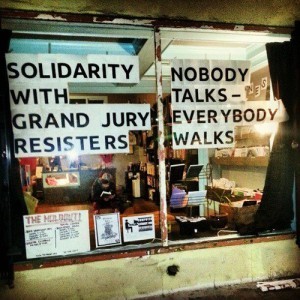Will Potter's Blog, page 22
January 18, 2013
If Right-Wing Violence Is Up 400%, Why Is the FBI Targeting Environmentalists?
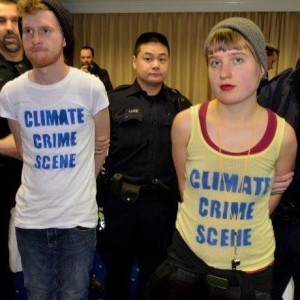 Violent attacks by right-wing groups and individuals have increased by 400% since 1990, and dramatically in the last five years, according to a new report by West Point’s Combating Terrorism Center.
Violent attacks by right-wing groups and individuals have increased by 400% since 1990, and dramatically in the last five years, according to a new report by West Point’s Combating Terrorism Center.
When examined side-by-side with FBI reports on domestic terrorism, the data from this study shows that the FBI has been either grossly miscalculating, or intentionally downplaying, murders and violent attacks by right-wing extremists while exaggerating the threat posed by animal rights activists and environmentalists, who have only destroyed property.
SHARP INCREASE IN VIOLENCE AGAINST MINORITIES
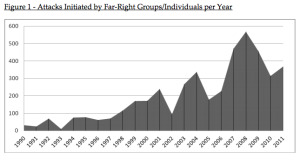
Between 2007 and 2011, there was a sharp increase in the number of victims of right wing violence, according to the study, to the highest levels documented so far. On a broader timeline, the increase is even more dramatic.
There was a spike in both from injuries and fatalities in 2007, and those levels have remained constant through 2012. That’s approximately 190 injuries a year, and 30 deaths, due to right-wing violence.
The victims of this violence are not surprising. Approximately 65% of the attacks were directed against ethnic and religious minorities. And 14% of violent attacks were against people because of their sexual orientation.
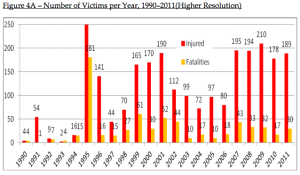
As the author notes, this only includes crimes that were reported and could be directly tied to right-wing politics.
It’s possible that these numbers are actually much higher.
FBI DOWNPLAYS RIGHT-WING THREAT
This data is troubling on its own, but it is even more disturbing that as right-wing violence has increased, the FBI has frequently downplayed the threat.
For instance, an FBI intelligence bulletin dated January 28, 2010 is titled “White Supremacist Extremist Violence Possibly Decreases.” It notes that, based on data from the FBI and open source reporting, violence by racist groups declined from 2007-2009. In this period, the FBI identifies 40 injuries and 7 fatalities; in the same period, West Point’s Combating Terrorism Center documented 599 injuries and 108 fatalities.
This is no anomaly. In my book Green Is the New Red, I combed through FBI terrorism reports, and the data sets the bureau uses to create them. I found that crimes by anti-abortion, racist, and militia groups were repeatedly absent.
The FBI has directed public attention elsewhere: in its chronological listing of terrorist incidents in the United States, the FBI says that in the three years after 9/11, every act of domestic terrorism, except for one, was the work of animal rights and environmental activists, including groups like the Animal Liberation Front and Earth Liberation Front.
In that period, right wing violence resulted in 283 injuries and 71 deaths.
In contrast, the crimes by animal rights and environmental activists physically harmed no one.
MISPLACED PRIORITIES PUT LIVES AT RISK
Disproportionately focusing time and money on animal rights and environmental activists, while more serious threats are minimized, wastes government resources and puts Americans’ lives at risk.

This concern has been raised within the federal government and law enforcement. A 2012 Congressional report on domestic terrorism examined the government’s crackdown on animal rights and environmental activists, and asked members of Congress to question why laws like the Animal Enterprise Terrorism Act single out political activists as terrorists when they have not harmed anyone.
In the context of right-wing extremism, the report said, “the crimes committed by animal rights extremists and eco-terrorists cannot be compared to clearly violent attacks…”
These concerns have also come from the Justice Department’s own Inspector General. The Justice Department warned as early as 2003 that the FBI’s obsessive focus on animal rights and environmental activists, the “number one domestic terrorism threat,” would leave more dangerous threats unchecked.
In a written response to the audit, the FBI refused to shift its focus.
The FBI continues to train agents on the threat posed by animal rights activists, environmentalists, and anarchists, and lists lawful, First Amendment activity and low-level criminal activity (such as civil disobedience) by these groups as examples of domestic terrorism.
“EASY TARGETS”
How do we explain the FBI’s misplaced priorities? Part of the explanation might be individual politics (as I’d wager most FBI agents lean more conservative than leftist). Part of it might be poor information gathering and reporting.
However, as the West Point report notes, we also need to take into consideration the nature of the victims:
“…some immigrant and minority communities,with a recent history in the United States, typically constitute a more vulnerable part of society: they have limited access to political power and economic resources and, as a result, are unable to secure severe sanctions against those threatening them; they are easy to identify and are likely to have contentious relations with law enforcement agencies. Thus, it is easy to understand why far-right elements might assume that attacking minorities will have limited potential costs in comparison to the costs of attacking other types of targets.”
And who are the targets of animal rights and environmental activists? Big Ag, the pharmaceutical industry, the energy industry. The most powerful corporations on the planet. Unlike minority groups, they do not have “limited access to political power,” they do not lack economic resources, and they do not have contentious relations with law enforcement (in fact they work very closely with them, and an entire industry of spy firms has risen to supplement those relationships).
The FBI’s priorities send a clear message that you can murder minority groups, and it will most likely be ignored. But if you are a member of those vulnerable communities, or if you effectively target the profits of multinational corporations, you may be listed as a domestic terrorist.
MOVING FORWARD

Years of manufactured hysteria about “eco-terrorism” have led to the normalization of unconstitutional surveillance, harassment, and entrapment of these movements. [As background on one of these plots, read Dean Kuipers' recent article in Outside: "Honey Stinger: The FBI used an 18-year-old woman called 'Anna' to infiltrate an alleged ecoterrorism cell. Did she stop a bomb plot before it came off? Or did she launch one?]
Mike German is a former FBI agent, who worked undercover to infiltrate right-wing groups. He’s now a senior policy counsel at the American Civil Liberties Union. He told me we need to be careful that this report isn’t used to expand these types of invasive tactics to other groups, even if they’re people you strongly disagree with.
“Hopefully this report will cause the FBI to re-examine its intelligence priorities to focus on real threats, and scale back invasive surveillance and investigative measures taken against Muslim-American communities, environmental activists and others where there is no reasonable evidence of wrongdoing,” he says. “My fear however, is that the FBI will instead use the report to broaden the number and types of groups it targets with suspicion-less investigations and unwarranted surveillance, and that will only violate more Americans’ rights.”
Instead, I think it’s clearly time for Congress to demand accountability, oversight, and an overhaul of the FBI’s domestic terrorism priorities. As President Obama prepares for the inauguration this weekend, it is time he addressed issues that he said were troubling to him as a U.S. Senator. To continue ignoring them is to invite further civil liberties violations, and potentially even bloodshed.
January 13, 2013
Environmentalist Miranda Gibson Has Lived in This Tree for More Than a Year to Protect the Forest
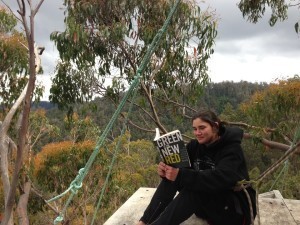 Record-breaking Australian temperatures have been so severe that a new color has been added to meteorological heat maps, and wildfires have been raging in Tasmania, destroying more than 100 homes. Through it all, environmentalist Miranda Gibson has maintained the longest-running tree sit in Australian history.
Record-breaking Australian temperatures have been so severe that a new color has been added to meteorological heat maps, and wildfires have been raging in Tasmania, destroying more than 100 homes. Through it all, environmentalist Miranda Gibson has maintained the longest-running tree sit in Australian history.
A friend sent in this photo of Gibson reading Green Is the New Red, and it prompted me to read up on the campaign, which I’m embarrassed to say I knew very little about. Gibson’s website, TheObserverTree.org, has a wealth of information, including regular blog entries about her experiences (posted from the tree tops!):
The ObserverTree is a platform situated 60m above the ground in an old-growth Eucalyptustree, in the heart of Tasmania’s southern forests. On the 14th of December 2011 conservationist Miranda Gibson climbed a rope to the top of the tree and vowed to stay untill the forest is protected. Miranda’s upper canopy home is a tree under imminent threat, in a forest due to be logged any day now…
This area of forest is in an area earmarked as one of Tasmania’s future forest reserves. It was promised protection by the State and Federal governments. Yet, if the logging industry has its way, it is going to be logged…
Gibson has lived in the trees for more than a year (395 days, as I write this) and has promised to continue the act of civil disobedience indefinitely until the Tasmanian forests are protected.
The dedication of Gibson and her support crew is truly inspirational. I hope you’ll follow the campaign on her site and Facebook page.
Oh, and what do you know — there are also plenty of activists using bold, creative tactics right here in the United States! And you can join them. For instance, check out the Tar Sands Blockade for more information.
Special thanks to Lilia for the photo!
January 10, 2013
Another Anarchist Refuses to Cooperate with Grand Jury, or Even Enter the Courthouse
 Three anarchists are in jail in Seattle for refusing to talk about their politics and other activists before a federal grand jury, and prosecutors have shown no signs of letting up. Another anarchist has now come forward about receiving a subpoena, and has refused to cooperate in any way — even entering the courtroom.
Three anarchists are in jail in Seattle for refusing to talk about their politics and other activists before a federal grand jury, and prosecutors have shown no signs of letting up. Another anarchist has now come forward about receiving a subpoena, and has refused to cooperate in any way — even entering the courtroom.
Portland anarchist Kerry Cunneen received a grand jury subpoena on December 14th, according to a statement published by the Committee Against Political Repression. The date was pushed back until January 3rd, but Cunneen refused to enter the courthouse.
“I will not cooperate with this grand jury nor will I in any way aid the state in its efforts to imprison people,” Cunneen said in a statement.
The grand jury appears to be investigating May Day vandalism at the Nakamura Federal courthouse in Seattle. Cunneen and the other grand jury resisters are not accused of those crimes, but were subpoenaed to the grand jury to answer questions about their political associations, their politics, and their friends.
Matt Duran, Katherine Olejnik, and Maddy Pfeiffer all refused to answer any questions during the grand jury hearing, saying it was a political witch hunt against anarchists because of their political beliefs. They are all in jail in Seattle, where they may remain for the full term of the grand jury. Cunneen risks similar jail time for taking a principled stand against cooperation.
Meanwhile, grand jury tactics are also being used to target animal rights activists in California.
Grand juries have historically been used against radical social movements to foster fear and distrust, and to intimidate activists into providing information about their communities.
“I am in solidarity with the May Day 5, with Maddy, Matt and Kteeo, and everyone else who has met repression with resilience,” Cunneen said. “To all whose solidarity has come in some form of action, it is inspiring and must continue.”
January 4, 2013
Breaking: Another Activist Subpoenaed to California Grand Jury
Yesterday another person was subpoenaed to testify before a federal grand jury in California investigating animal rights activists.
Priyesh Patel of Portland, Oregon, was served a subpoena Thursday while at work, and is scheduled to appear at the San Francisco federal courthouse on January 29th.
Grand jury proceedings are secret, but this grand jury appears to be investigating arson and other property crimes in Santa Cruz that occurred in 2008, in relation to animal rights campaigns against animal experimentation by the University of California system.
Other animal rights activists have been subpoenaed as well. In November, I wrote about the case of Brittany Kenville. [For background: “I plan on exercising every right that I have” to oppose California grand jury, activist says"]
Patel, Kenville, and other activists subpoenaed are not charged with any crime. Grand jury proceedings are used to determine if there is sufficient evidence to bring a criminal indictment against someone else. Ostensibly, this may act as a safeguard against overzealous prosecutions. However, grand juries have historically been used as a tool to harass, disrupt, and spy upon social movements.
When political activists are subpoenaed to a grand jury, they are not allowed to have an attorney present. They can be asked about who they are friends with, what they believe, and what types of activism they are engaged in. If they refuse to answer questions about their political beliefs and political associations, and refuse to participate in this fishing expedition, they can be imprisoned.
That’s exactly what has happened in Seattle. The grand jury there is investigating anarchists, and those who refuse to talk about their community have been thrown in jail. [For background: "Fourth Person Jailed for Refusing to Talk about Other Anarchists in Grand Jury"]
I’ll post more information leading up to this grand jury date, but in the meantime please consider writing a letter to the grand jury resisters who are in jail for remaining silent.
December 27, 2012
Fourth Person Jailed for Refusing to Talk about Other Anarchists in Grand Jury
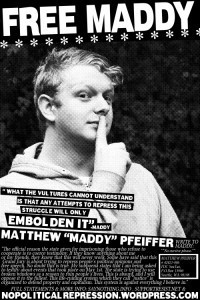 A fourth person has been jailed for refusing to cooperate with a federal grand jury that is targeting anarchists in the Pacific Northwest.
A fourth person has been jailed for refusing to cooperate with a federal grand jury that is targeting anarchists in the Pacific Northwest.
Maddy Pfeiffer self-surrendered to the Seattle, Washington federal detention center on Wednesday, December 26th as ordered by the court. Pfeiffer was accompanied by friends and supporters before being taken into custody.
Pfeiffer had previously appeared before the grand jury and asserted 1st, 4th, and 5th amendment rights in response to every question asked.
This is now the fourth person who has been imprisoned for refusing to testify before the grand jury about their political beliefs and political associations. Matt Duran and Katherine Olejnik have been in jail since September, and Leah Plante was released in October. [For background about them: "3 People Now in Jail for Refusing to Talk About Other Anarchists"]
It’s unclear how long they may be imprisoned. The purpose of the imprisonment, according to the court, is to pressure them to cooperate with grand jury questioning.
Pfeiffer, Duran, and Olejnik say the grand jury is targeting them because they are anarchists, and they will not cooperate with what they say is a political witch hunt.
You can write Pfeiffer a letter here:
Matthew Pfeiffer #42421-086
FDC SeaTac
P.O. Box 13900
Seattle, WA 98198
December 20, 2012
Another Anarchist Will Be Jailed December 26th for Resisting Grand Jury
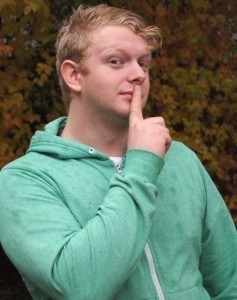 On the day after Christmas, it is likely that another anarchist will be imprisoned for refusing to talk about their political beliefs and their friends before a federal grand jury in Seattle.
On the day after Christmas, it is likely that another anarchist will be imprisoned for refusing to talk about their political beliefs and their friends before a federal grand jury in Seattle.
Maddy Pfeiffer, 23, appeared at a contempt hearing last week and was ordered by Judge Jones to self-surrender to SeaTac FDC at 9 a.m. on December 26th. Pfeiffer had previously appeared before the grand jury and asserted 1st, 4th, and 5th amendment rights in response to every question asked.
Pfeiffer will join two other young anarchists who are currently imprisoned for making the same principled stand, refusing to talk about their political activism and refusing to help the government identify leftists and protesters in th Northwest. [As background: "3 People Now in Jail for Refusing to Talk About Other Anarchists"]. It’s possible that they will remain imprisoned for the full term of the grand jury, until March of 2014.
The grand jury appears to be investigating vandalism in Seattle during the May Day protests. But Lauren Regan, an attorney with the Civil Liberties Defense Center, learned that the grand jury was empaneled March 2, 2012 — before the May Day protests even took place. Activists, civil liberties advocates, and journalists have expressed concern that the grand jury is being used for social mapping of anarchists and leftists.
Using grand juries to harass, surveil, and disrupt social movements is nothing new. Robert Meeropol, son of Julius and Ethel Rosenberg, noted how grand juries have been used during the Red Scare, through the 1960s, and today:
Grand juries have been used as instruments of political repression for decades. My parents, some family members, and their friends were hauled before a grand jury in 1950. Some, cooperated, pointed the finger at others and even helped send my parents to their deaths with their testimony. They received reduced sentences or no prison time. Those who did not cooperate, but were not indicted, were harassed by the prosecuting authorities for many years afterwards. Those the grand jury indicted, who were then tried and convicted, went to prison or were killed.
While the stated purpose of the grand jury was to expose criminal behavior, it also served to sow anxiety and distrust throughout the community of activists who had any connection to my parents, as well as to spread fear among the broader progressive community. Grand juries stifle activism and dissent in this manner.
In the face of this, anarchists in the Northwest have received international support from diverse social movements. Hundreds of supporters called and emailed District Judge Richard A Jones during a day of action. Teach-ins have taken place around the country. Benefit concerts have helped defray legal costs. “Anon-ops” activists disrupted the district attorney’s office.
Pfeiffer, Katherine Olejnik, and Matt Duran say they have drawn inspiration and strength from that outpouring of support. The Stranger’s Brendan Kiley interviewed Olejnik and Duran in jail, and reports:
They haven’t been accused of a crime. They haven’t even been arrested for a crime. They’re here because they refused to answer questions for a federal prosecutor, in front of a grand jury, about people they may (or may not) know: who those people are, who those people hang out with, and what political opinions those people hold…
How, I ask Duran, would you explain why you’re here to people on the outside?
“Not everyone will understand,” Duran says in a soft voice. “You have to be in a different state of mind to be willing to go to jail to protect someone you basically have no knowledge of.” He talks about his years as a young student in the Army ROTC, when veterans would come and talk about serving their country because they felt a sense of duty. Not answering questions about other people, he says, “is the duty I can perform.”
What can you do?
Time in jail can feel especially dark during the holidays. (Kiley’s article, above, captures this well, and I hope you will read it). Now would be a great time to write a letter to those imprisoned:
Matthew Kyle Duran #42565-086
FDC SeaTac,
P.O. Box 13900
Seattle, WA 98198
Katherine Olejnik #42592-086
FDC SeaTac,
P.O. Box 13900
Seattle, WA 98198
December 19, 2012
Welcome Home, Daniel McGowan
 For the past four years Daniel McGowan had been imprisoned in two experimental prison units, called Communications Management Units, that radically restrict prisoner communication with the outside world. CMU prisoners are allowed only a handful of minutes on the phone each month, and they not allowed any physical contact during visits — not a hug, not even a handshake.
For the past four years Daniel McGowan had been imprisoned in two experimental prison units, called Communications Management Units, that radically restrict prisoner communication with the outside world. CMU prisoners are allowed only a handful of minutes on the phone each month, and they not allowed any physical contact during visits — not a hug, not even a handshake.
“I haven’t been able to hug my husband, or even hold his hand, for two years,” said McGowan’s wife, Jenny Synan, in a lawsuit by the Center for Constitutional Rights against the facilities. “This proposed rule does not explain how prohibiting a husband from holding his wife’s hand or keeping a father from hugging his daughter, is necessary for prison security.”
McGowan was recently released from the CMU in Terre Haute, Indiana, and driven by federal authorities to Indianapolis International Airport. There he met his wife, and the two traveled home to New York City together.
“It’s crazy to think its been 7 years since the day I was arrested at work but I’m glad to be on this path now and to be looking forward,” McGowan said in an email to friends. “…I can’t really express my gratitude for all the love, support, books, letters, visits, and random acts of kindness thrown my way these past 7 years — I tell people all the time I have been so profoundly spoiled by an amazing group of friends, family and allies.”
McGowan was arrested in December, 2005, and imprisoned a year later for his role in two arsons claimed by the Earth Liberation Front. Much of his time imprisoned was spent in two CMUs, one in Marion, IL, and the other in Terre Haute, IN. According to the government, CMUs are for prisoners with “inspirational significance.” In other words, they are used to isolate political prisoners like Daniel McGowan from the social movements that support them. [To learn more: "5 Things You Should Know About America’s “Little Guantanamo”]
The journey home is not complete, however. McGowan was released to a halfway house in New York, where he will be living for at least the next few months. After that, there will be three years of supervised release.
McGowan is quickly adjusting to life post-prison. He has started work at a law firm, and says he’s excited about vegetarian restaurants that are close enough for lunch breaks.
And McGowan, who always seems to be working, is busy catching up on the last seven years. Yesterday I received a reply to an email I sent to his support group while editing the book. It was dated December 19, 2010.
I asked him if he’s really going to read through all the emails since he has been away.
“oh, i totally am. there are only 10,000 messages in the account,, should take a week.”
Daniel McGowan has been released, but there are many other political prisoners needing your support. Please take a moment and write a letter to the anarchist grand jury resisters in the Northwest, the Cleveland 4, or others.
December 10, 2012
15 Holiday Gift Ideas Your Activist Friends Will Love
 Need some holiday gift ideas for your friends and family who are out there trying to fight the good fight?
Need some holiday gift ideas for your friends and family who are out there trying to fight the good fight?
Here’s a few, all from independent businesses, journalists, publishers and artists who trying to do the same. Most of these folks are dear friends of mine, and I hope you’ll support them however you can:
“Never Read the Comments” tote from Food Fight vegan grocery. #1 rule for surviving the internet.
“The Do-It-Yourself Guide to Fighting the Big Motherfuckin’ Sad” by Adam Gnade. Get a few for your friends, but keep one for yourself when you need an uplifting kick in the ass.
Make a donation to Mercy For Animals, Compassion Over Killing, Sea Shepherd Conservation Society, or your local activist group in a friend’s name.
“I’m Vegan and I Love You” t-shirt from Herbivore. Or, anything from Herbivore.

Green Is the New Red. You knew that was going to be on here!
“Respect Existence or Expect Resistance” shirt from the Sparrow Media Project
Join the Civil Liberties Defense Center – Lauren Regan and the CLDC have always out front opposing the labeling of activists as “eco-terrorists.”
Slingshot organizer. For planning the revolution.
Signed, numbered screenprint by Matt Gauck.
Black Flags and Windmills, inspirational account by longtime anarchist organizer Scott Crow.
T-shirts to benefit Brittany Kenville.
Eaarth: Making a Life on a Tough New Planet by Bill McKibben
“Scent of Scandal” vegan candles. Including “Santa’s Pole” and “Challahback Girl.”
Wall calendar by our friend Kurt Halsey.
Big Lebowski button set. This isn’t activist-related. But The Dude abides.
December 9, 2012
I’m teaching a university course this spring. Want to sign up?
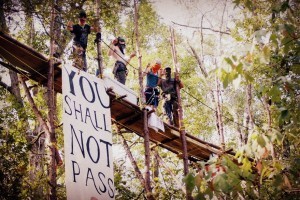 I’m excited to announce that I’ll be teaching an online course for the University of Southern Maine this spring: “Investigative Journalism and Social Change: Reporting on Animal and Environmental Issues.” (Perfect fit, huh?) When I posted about the course on Facebook there was a considerable amount of interest, so I wanted to share it here as well. Anyone can enroll, including non-matriculated students. (Here’s more information on how). And a description of the course is below:
I’m excited to announce that I’ll be teaching an online course for the University of Southern Maine this spring: “Investigative Journalism and Social Change: Reporting on Animal and Environmental Issues.” (Perfect fit, huh?) When I posted about the course on Facebook there was a considerable amount of interest, so I wanted to share it here as well. Anyone can enroll, including non-matriculated students. (Here’s more information on how). And a description of the course is below:
ENG 310: Investigative Journalism and Social Change:
Reporting on Animal and Environmental Issues (class #13807)
Course description:
This course explores the role and responsibility of journalists in shaping the national dialogue on social issues, and the qualities and techniques of investigative reporting. Animal rights and environmental issues have entered mainstream public consciousness like never before, but how these issues are discussed will be our focus; these issues will offer the framework for an in-depth case study of investigative journalistic practices, and their social impact. What are the often unspoken value assumptions behind journalists’ decisions within a story? What is the role of investigative journalists in providing checks and balances on power? How do both political activists and their opponents seek to use the press to shift public opinion? Is it possible for journalists to be unbiased? We will discuss these questions and many more by examining a wide range of materials including investigative journalism, “citizen journalism,” communiqués from underground groups, activist campaign materials, FBI files and internal corporate strategy documents. The course will be divided into three broad areas: understanding journalistic conventions, investigating activist campaigns, and examining the public relations strategies used to sway journalists.
Within the three broad areas mentioned above, we’ll be using activist campaigns as case-studies, including Earth First!, the Sea Shepherd Conservation Society, PETA, Stop Huntingdon Animal Cruelty, and undercover investigations by Mercy For Animals and others.
I hope students will enjoy the readings, which include magazine articles (from The New Yorker, Outside, Rolling Stone and more), a few books, FBI documents, industry publications, and anti-activist public relations guides.
I can’t wait. If you’re interested, or know someone who might be, would you mind sharing this? This is my first time teaching a course like this, and a strong enrollment would help show the university that there’s interest in the topic. Thanks!
November 30, 2012
“I plan on exercising every right that I have” to oppose California grand jury, activist says

Brittany Kenville.
An activist who has been subpoenaed to a grand jury in California investigating the animal rights movement says she will exercise every right to oppose it and that “using grand juries to harass activist communities does not serve justice, it is simply a means of political repression.”
Brittany Kenville is one of several activists who have been subpoenaed to the grand jury, which appears to be investigating a 2008 fire at the home of an animal experimenter at the University of California, Santa Cruz. In a statement Kenville noted that grand juries have historically used the pretense of a crime, such as the 2008 arson, as justification for threatening activists with jail time if they do not testify about their political beliefs and political associations.
“Grand juries operate in secrecy, and witnesses who choose to testify are not allowed to have a lawyer present when doing so,” Kenville says. “In cases like this, grand juries are used as a tool to strike fear in and intimidate activists, and also to neutralize them from action. They spread seeds of mistrust throughout activist movements, and they operate under the assumption that people in activist communities are inherently guilty by association. I am adamantly opposed to these proceedings. I believe that they are unjust and an appalling misuse of prosecutorial power.”
Kenville has previously been subpoenaed to testify before the grand jury, and may be asked again to appear. If she refuses to answer questions about her personal beliefs or her friends, it is possible that she would be imprisoned for the duration of the grand jury.
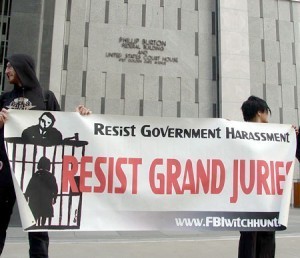
Grand juries have been used against animal rights activists for decades.
This looming threat is made more real against the backdrop of another grand jury currently convened in Seattle, Washington. A series of Joint Terrorism Task Force raids in the northwest targeted local anarchists. Two anarchists are currently imprisoned for refusing to take part in what they call a political witch hunt. A third, Maddy Pfeiffer, is scheduled to appear again in December (after refusing to answer any questions previously).
In some instances, this threat of jail time is enough to persuade activists to turn on their friends and testify. This is certainly the case when prosecutors subpoena individuals who don’t know their co-defendants well, if at all, and don’t consider themselves particularly active in “the movement.”
When I spoke with Kenville recently, what struck me was that she had no interest in any of these kinds of justifications; she said she would oppose the grand jury and has the full support of her friends, other activists, and most importantly her family.
Brittany Kenville’s full statement is below:
My name is Brittany Kenville. I have been subpoenaed as a witness to the grand jury convened in San Francisco in relation to events that took place in Santa Cruz, California in 2008. Grand juries exist to determine whether there is enough evidence for a person or persons to be indicted. Subpoenas are used to force the appearance at grand juries by anyone the prosecution feels may provide evidence in support of their case.
Grand juries operate in secrecy, and witnesses who choose to testify are not allowed to have a lawyer present when doing so. In cases like this, grand juries are used as a tool to strike fear in and intimidate activists, and also to neutralize them from action. They spread seeds of mistrust throughout activist movements, and they operate under the assumption that people in activist communities are inherently guilty by association. I am adamantly opposed to these proceedings. I believe that they are unjust and an appalling misuse of prosecutorial power. Using grand juries to harass activist communities does not serve justice, it is simply a means of political repression.
I have been working with an attorney, and I plan on exercising every right that I have in response to my subpoena. I have the complete, unfaltering support of my family, my friends and my fellow activists. I encourage anyone else who is subpoenaed to reach out, seek counsel, do research, and learn your rights in these proceedings. I hope everyone reading this will learn more about the grand jury system and join me in standing up against its use as a tool of harassment.
In solidarity, Brittany Kenville
Please consider making a donation toward Brittany Kenville’s legal fees. You can do so on her Tumblr.

